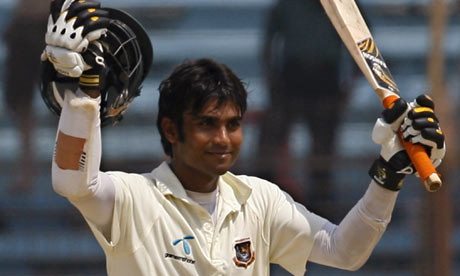Thank you ...
Bangladesh have need for speed after a decade of slow progress
Critics claim Bangladesh should not be a Test nation, but with the right infrastructure they will develop the bowlers to compete

Junaid Siddique's century against England was evidence of Bangladesh's progress, but now they need to improve their bowling. Photograph: ANDREW BIRAJ/REUTERS
If some of the pundits had their way it would be a long time before England toured Bangladesh again. There have been plenty of suggestions that Bangladesh, beaten by 181 runs, should be demoted from Test cricket, either down to a second tier of nations or out of the cycle altogether. It is a viewpoint that I would question.
Poor as Bangladesh were in patches, England still needed to play proper cricket to beat them. We saw in this match that Bangladesh are improving as a side. If you plotted a graph of their progress since they came into Test cricket, the line would be curving steadily upwards. Junaid Siddique's 106 in the second innings made him the fifth Bangladeshi batsman to score a Test century since 1 January. That is as many centuries in the last two and a half months as the team managed in the previous four years.
It has been 10 years since Bangladesh made their Test debut. In that time they have played 65 matches and won three of them. Critics have short memories. That record is in line with the trend for emerging Test nations. In their first 10 years of Test cricket, between 1982 and 1992, Sri Lanka played 37 Tests, and won two. In New Zealand's first decade they played 14 times without winning once (and took 45 matches to do so). No doubt there were people who wanted to kick those teams out of Test cricket then, too.
Where Bangladesh's record does differ is in the number of draws they have secured, only six, as opposed to Sri Lanka's 16. Sri Lanka were lucky in that they went on to discover Muttiah Muralitharan and were able to build a bowling attack around him. In the absence of such a star spinner, Bangladesh's big difficulty is fast bowling. There are two sides to the problem – their batsmen are not comfortable facing it, and their bowlers are not capable of delivering it. The first issue can be fixed, but the second is tougher to solve.
The weaknesses of their top order against fast bowling were clear in the first innings of this Test in Chittagong. Both Siddique and Imrul Kayes were bounced out. I know from my own playing days with Zimbabwe just how difficult it is as a batsman in a developing team to deal with the step up in pace that occurs when you play a top nation. It is a real shock to the system to come out of a net or a first‑class game where the bowling has been at 130kph to face a barrage in a Test match at 140kph.
That extra 10kph may not seem much on paper, but imagine it as the difference between a spin bowler's regular delivery and his arm-ball. The change in pace is similarly slight but very effective. In Zimbabwe we actually recruited two South African baseball pitchers to come into the nets and throw at us as fast as they could from 19 yards, to help us adapt to the pace of top-level cricket. At first we could hardly get the bat on the ball, but over time we became accustomed to the increased speed. Until Bangladesh can find some quicks of their own for their batsmen to practise against, they may need to resort to more unnatural methods like that one.
Developing that bowling talent is a tough task. Even India have faltered because they do not have a consistent squad of pace bowlers who can really intimidate the opposition. Bangladesh face similar difficulties. Between the flat wickets and the heat and humidity of the conditions, not many young players are going to want to run up and bowl at 140kph for any period of time. One way forward would be to develop wickets that offer more encouragement for seam bowlers.
But the bedrock for future development is what is happening underneath Test cricket. I would want to visit and inspect Bangladesh's domestic set-up before passing judgment, but wherever you are in the world strong first‑class cricket is absolutely crucial for Test success. You can't pluck players from a weak domestic league and expect them to make a quick transition to the top level. This also takes time. Bangladesh have had 10 years to work on their domestic structure. England have had more than 100, and still not got it right.
Bangladesh have a part to play in the modern game. Their huge cricketing population is a resource that the sport should not waste. If you suddenly split Test cricket into two divisions then that interest will wane. England's visit will stimulate enthusiasm in a way that playing Ireland and Zimbabwe never would. The mismatches, we are told, are doing nothing for the health of Test cricket, but what about the longer-term development of the sport? Cricket would only benefit from Bangladesh getting better.